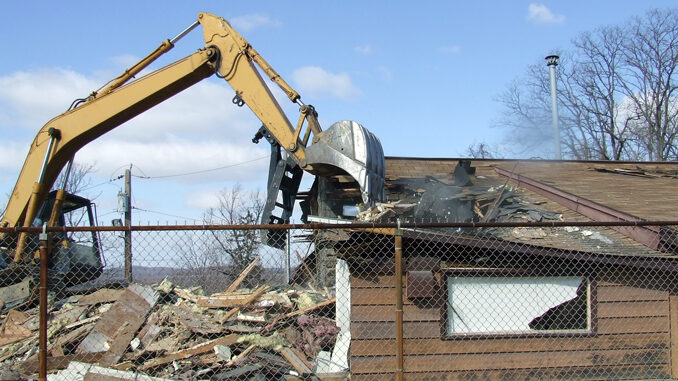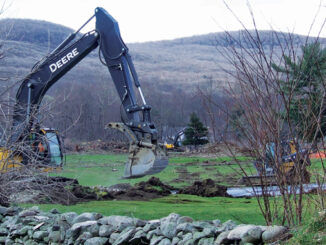
Taking a look at the recent history of Storm King Golf Course
By DAVID NOLAND
(This is Part One of a three-part article about the transformation of the Storm King Golf Course from a sleepy local club to a lavish privately-owned golf practice facility for the West Point golf team. Part 2 and Part 3 will appear in the July 22 and July 29 editions.)
One Saturday morning in March of last year, Ted Warren awoke to the buzz of chainsaws and the crack of breaking tree branches outside his window. Warren lives on Hasbrouck Avenue in the house he grew up in, across the road from the third tee of the Storm King Golf Club. He looked out toward the golf course and was horrified by what he saw: huge excavators pushing over large mature trees, while gangs of lumberjacks dismembered them. Piles of severed trunks and branches littered the third and fourth fairways. “They were cutting down beautiful trees I’d been looking at since I was a kid,” Warren recalls. “It was very upsetting.”
In that same jolting manner, many of us in Cornwall learned for the first time that day of the big changes afoot for the beloved golf course that has been the scenic heart of the town for more than 100 years. Set on 64 acres a few minutes walk from Main Street, bisected by a meandering creek, and offering expansive views of Black Rock Forest, the Storm King Golf Club had been a leafy refuge for thousands of Cornwall golfers over the decades, not to mention legions of off-season dog-walkers, cross-country skiers, and sledders.
But all that was about to change. It turned out that a rich guy from Texas had bought the property, and planned to spend $8 million to transform the course and clubhouse into an elaborate practice facility for the West Point golf team, and a site for golf events for disabled veterans.
For more than a year now, we’ve watched that transformation unfold. The process has been marked by the roar of bulldozers and the sculpting of vast mountains of dirt, as well as political controversy and uncertainty about the property’s role in the future of the town. Will Cornwall residents be able to play golf there? How about the walkers and skiers and sledders? Will the Storm King Tavern, with its breathtaking views, be part of town social life once more?
Or will the course be more like a Faberge egg under museum glass: an expensive and lovely man-made artifact that we can only look at from the outside, but not touch?
The Storm King Golf Club, founded in 1894. had a long and storied history. The Stillmans, the wealthy New York banking family that has loomed large in Cornwall for more than a century, provided the land on which the course was built. I joined the club in the 1980s, and was a member for more than 30 years. I didn’t mind that it was only a nine-hole course. (You just went around twice to get the full 18.) I loved the convenient location; sometimes I’d hop over and play holes No. 3 and 4 while waiting for Chinese take-out at Cornwall Plaza. And the cozy, charming little clubhouse at the top of the hill was always welcoming.
I had some great moments on those 64 acres. An eagle on the first hole when my 120-yard wedge shot rolled into the cup. Shooting a 73 one magical round when everything went right. That crazy day I played 216 holes in a dawn-to-dusk charity marathon.
And there were splendid non-golf moments as well. Schussing down through six inches of fresh powder on the hill below the clubhouse. Spotting the elusive planet Mercury (for the first and only time in my life), just above the horizon at sunset, from a high vantage point above the first green. Pushing my infant daughter along in a jogger-stroller as I played a solitary 6 a.m. round to give my exhausted wife a chance to sleep in.
And of course there was the winter sledding. For years, after every snowstorm I’d take Callie to join the swarms of kids careening down the steep hill by the second tee. Sledding on the golf course had been a tradition for generations of Cornwall kids, and I loved the sense of community it kindled in me.
This lovely reality began to unravel in 2006. Several members of the club’s Board of Directors came up with the idea of building a new clubhouse. The old one needed expensive repairs, they insisted. A bigger, fancier new clubhouse would attract more members. More members would bring in more revenue, and annual dues might actually go down, we were told. (As I recall, at the time I was paying about $900 a year.)
Estimated cost of the new clubhouse as they envisioned it: $1.35 million. The Board appointed a club member with fiscal expertise, Main Street financial adviser Randy Clark, to head a committee to look into the matter. Clark consulted three local bank CEOs; none would offer a mortgage of more than $925,000. But Clark found a builder willing to do a more modest Adirondack-style clubhouse for that amount.
The Board flatly rejected that idea. It was the $1.35 million job or nothing. And they were eventually able to find their financial angel: Connect One, a local bank in northern New Jersey, which was willing to give them a mortgage for the full $1.35 million.

The Board never bothered to ask us lowly rank-and-file members how we felt about their clubhouse deal. I, for one, liked the old clubhouse just fine. And by my rough calculations, the interest payments alone on the $1.35 million mortgage would cost about $600 per year for each of us 175 or so members. (Lower dues? How was that possible?) Every other member I talked to agreed with me. Only a handful of us mere members wanted the new clubhouse.
The Board was set to formally vote on their clubhouse plan at a special meeting in January 2008. The 20 or 30 of us members who showed up were informed that we were not allowed to talk during this meeting. Only listen. And what we heard was this: Clark, the financial committee chairman, reported that the Club could not afford the new clubhouse deal as presented. Then the club Treasurer stood up and offered his assessment: nope, too expensive, we couldn’t afford it.
The Board immediately approved the deal by a vote of 13-3. The club Treasurer resigned the next day.
Club by-laws required that if the Treasurer recommended against a proposed capital outlay, the matter must be submitted to the general membership for a vote. That never happened.
What did happen was no surprise. (To me, at least.) The new clubhouse got built, though not without some financial skulduggery. (The Board member in charge of the construction didn’t pay all the subcontractors.) Annual membership dues started ratcheting up. As a result, membership steadily fell, in spite of the fancy new clubhouse. When dues hit $2,000 a year, I reluctantly joined the exodus. The fiscal vicious circle spun ever tighter, and the number of full dues-paying members eventually dwindled to less than 20.
With shrinking income, the club couldn’t make the mortgage payments and declared bankruptcy. The bank foreclosed in 2010, and was shocked to learn that a restriction in the original deed from the Stillmans required that the property remain a golf course. (No quick sale to a housing developer.)
The bank found a golf management company to keep things running. Annual dues dropped back to pre-clubhouse levels, and many of us refugees rejoined. But we were clearly on borrowed time; the bank’s ultimate goal was to sell the property as soon as possible. One potential buyer’s proposal for a high-end health/spa/golf resort, complete with pool and tennis courts, fell through because of the deed restriction.
But just how iron-clad was that Stillman deed restriction? Would the family, now scattered across the country, have the stomach to wage a long, expensive court battle with a housing developer determined to find a way around the restriction? Would a simple financial buyout do the trick? That was the nightmare scenario: the scenic heart of Cornwall clotted with McMansions, or worse.



